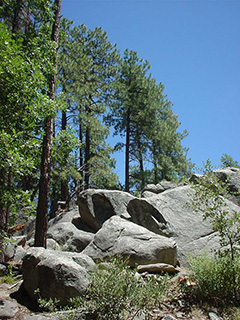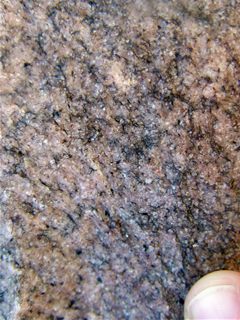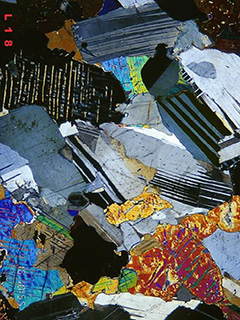Prelude
Igneous rocks form from molten liquid rock or magma. Magma originates from shallow depths (a few kilometers) to very deep (below 100 km), and since it is typically more buoyant than the surrounding rock, it rises toward the surface. Commonly, the ascent stops before reaching the surface and the magma crystallizes to form a plutonic (or intrusive) rock in subterranean magma chambers of various shapes that are termed plutons or intrusions.
Since magma is insulated by the surrounding wall rock, it loses its heat rather slowly. Depending on the composition of the magma, certain minerals will start to crystallize at a few starting points (called nucleation points) and slowly grow into larger, interlocking crystals that are big enough to see without a microscope. Each type of mineral will crystallize over a range of temperatures, with the first crystals forming at higher temperatures, followed by others at progressively lower temperatures until all the liquid magma is gone. All this happens deep within the Earth, but we know what happens from experimental laboratory studies
We typically can name igneous rocks and interpret their origins by observing both the arrangement and type of crystals in the rocks. There are several types of plutonic rocks (granite, gabbro, diorite, peridotite, etc.), each with its own distinct mineral composition. These rocks are named after Pluto, the mythological Greek god of the underworld (not the dwarf-planet or Mickey's dog). Someone who studies such rocks and processes is called an igneous petrologist.
|
Figure 5-1. Plutonic igneous rocks in the field, in outcrop, and under the microscope. At left, the Crooks Canyon Granodiorite forms massive boulders in the forest near Prescott, Arizona. The Elves Chasm Granodiorite, the oldest known rock in Arizona (1840 Ma), is exposed at Colorado River mile 116.5 in the Grand Canyon (center). A thin section of the plutonic rock gabbro viewed under the microscope (right). Remember to click on highlighted images to see larger versions. |
||
What Will You Do Today?
|
Identify and describe different types of plutonic igneous rocks and their constituent minerals, and read geologic maps and cross sections having igneous features |
A. Plutonic Rock Texture & Composition - Learn about different kinds of plutonic textures and compositions
B. Identifying & Interpreting Plutonic Rocks - Classify, identify, and interpret different kinds of plutonic igneous rocks using various methods
C. Plutonic Rocks in Geologic Maps - Read two geologic maps, concentrating on the plutonic rocks
D. Plutonic Rocks & Structures in Sequence Diagram - Learn about different magma chamber shapes and solve a sequence diagram that is full of intrusions



